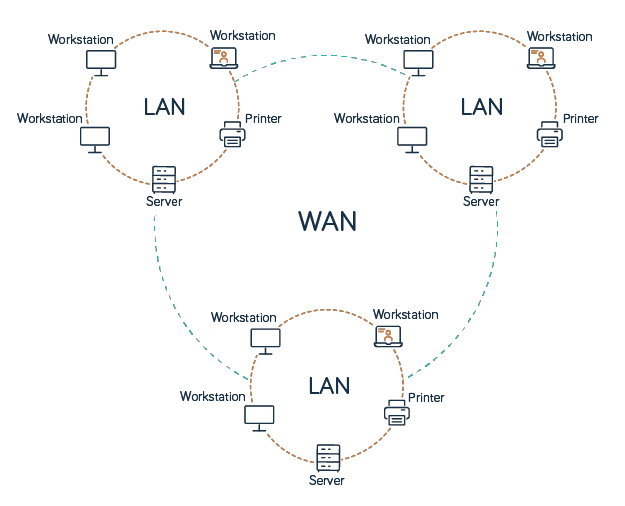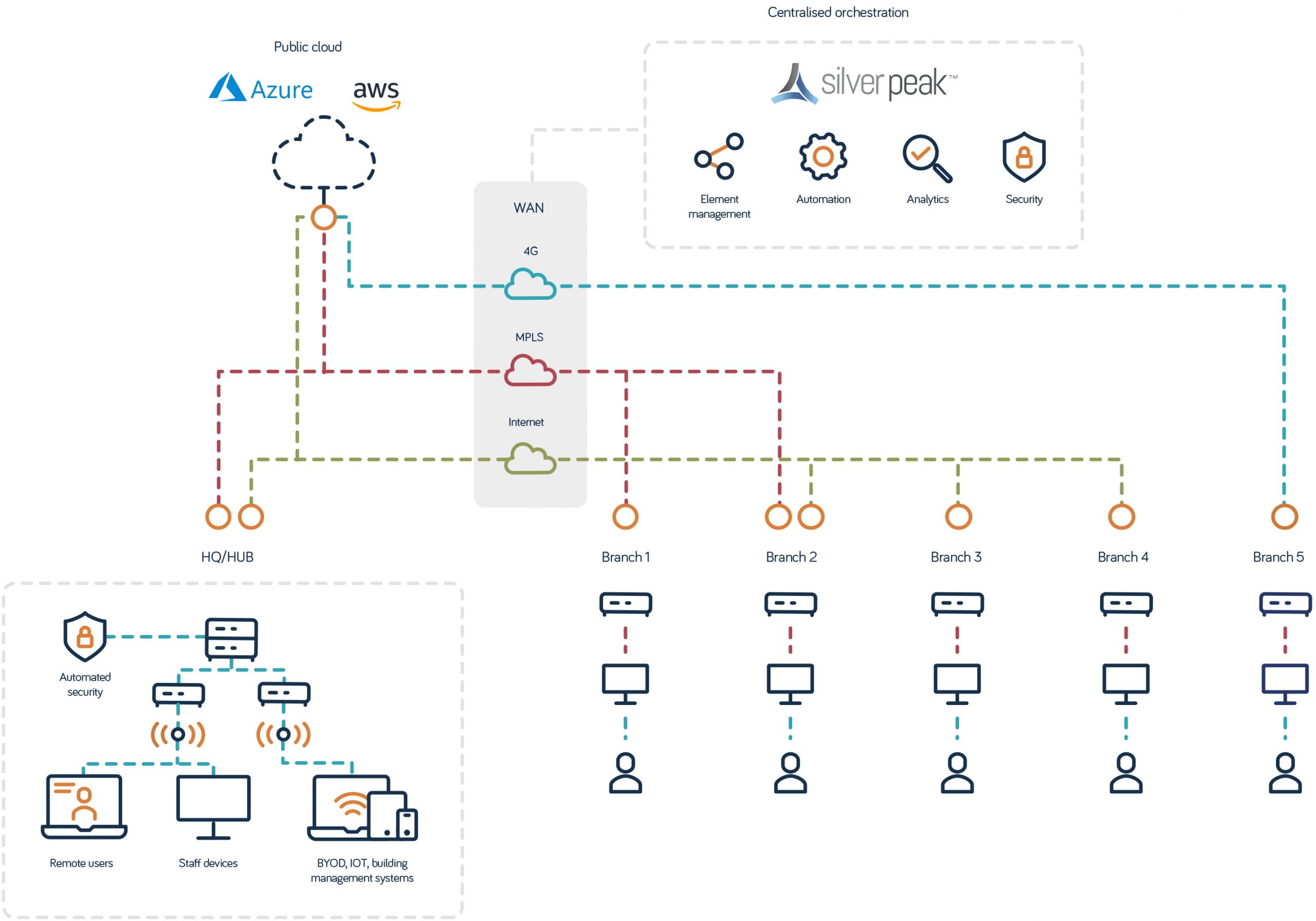An enterprise WAN is a network that allows large organisations to securely exchange information over long distances. Learn why you need a WAN, how they work, and which enterprise WAN solutions could help your business.
- What is an enterprise WAN?
- Why do you need an enterprise WAN?
- How does an enterprise WAN work?
- Enterprise WAN solutions
- IP-VPN vs SD-WAN
- Enterprise WAN FAQs
What is an enterprise WAN?
An enterprise WAN (wide area network) is a computer network that connects an organisation's premises over long distances to form a single, typically private, network. A WAN joins a series of local area networks (LANs) that may be geographically spread around the country or across borders to form a seamless network of networks.
For example, a bank may use an enterprise WAN to connect the LANs of local branches with the company’s head office. The same WAN may also connect to cloud services or offices worldwide, giving employees access to the bank’s critical assets in one private network.
Why do you need an enterprise WAN?
An enterprise WAN is essential for large organisations to securely connect multiple sites over a wide area to exchange information privately.
Multinationals use WANs to connect their sites around the globe. But they’re essential for any large company with multiple, dispersed sites, especially given the rise of remote working.
An enterprise WAN can:
- Securely connect remote offices, data centres, cloud storage and employees
- Provide central access to company resources like databases and software
- Enable video conferencing, file sharing and other types of real-time collaboration
- Allow IT staff to monitor and control traffic and applications in use across the network
- Enforce common policies and security measures
How does an enterprise WAN work?
A traditional enterprise WAN connects a large organisation’s local area networks (LANs) to form a single secure network for data exchange. For example, a supermarket chain might use a WAN to connect the LANs of its head office, warehouses and local stores nationwide.

Wide area network (WAN)
In a traditional WAN, the networking infrastructure is based on routers and virtual private networks (VPNs). Traffic is typically routed using leased lines or Multiprotocol Label Switching (MPLS), a technology introduced in the early 1990s.
With the rise of cloud computing, remote access and applications like VoIP and video conferencing, enterprise WANs need more flexibility. Today, companies increasingly use Software-Defined Wide Area Networks (SD-WAN), which allow multiple connectivity options and direct connections to the cloud.
However, MPLS-based WANs still have some advantages over SD-WAN. That’s why you need to weigh up specific solutions to see what’s right for your business.
Enterprise WAN solutions
Which WAN technology is right for you will depend on your organisation's size and specific requirements. At Neos Networks, we offer two enterprise WAN solutions designed to meet your needs: IP-VPN and SD-WAN.
IP-VPN
Our MPLS-based solution, IP-VPN, is commonly used for connecting organisations with multiple sites or offices and has long been the go-to technology for IT, voice and data networking.
IP-VPN provides 24/7 monitoring and management with support from our Network Operation Centres (NOCs), ensuring continuous uptime and optimal use of network bandwidth. It enables our customers to create a private network across shared infrastructure and prioritise data types to manage the performance of their network.

How IP-VPN works
SD-WAN
SD-WAN splits connectivity (the underlay) from the management of traffic on the WAN (the overlay). This creates a single, seamless view of the network regardless of the connectivity used. It also allows you to breakout to the internet locally if that improves performance for end users, as well as connect all your offices to cloud services.
Unlike IP-VPN, managed SD-WAN solutions can access the cloud directly and support Zero Touch Provisioning (ZTP) for quick and easy deployment.

How SD-WAN works
IP-VPN vs SD-WAN
As more businesses look to integrate cloud services and mobile apps in their networks, many want the flexibility and agility SD-WAN offers. However, IP-VPN may still be the better option for your business, depending on your needs.
IP-VPN vs SD-WAN
| Why use IP-VPN? | Why use SD-WAN? |
| Get a dedicated network: A secure, private IP-VPN network is ideal for processing highly sensitive information, like financial, health care or government data. | Integrate with the cloud: Direct connection to cloud services allows you to optimise access to cloud-based applications (SaaS, IaaS and PaaS). |
| Completely control your data: All internet traffic is backhauled to a data centre, allowing real-time data inspection and prioritisation. |
Optimise data traffic: Real-time traffic steering lets you prioritise and reroute traffic for greater flexibility. |
| Ensure enterprise-grade security: A dedicated network allows you to implement industry-specific standards across the WAN. | Deploy and scale fast: Zero-touch provisioning makes SD-WANs quick and easy to deploy and scale as your business grows. |
| Optimise Quality of Service (QoS): Multiple classes of service ensure each application gets the required bandwidth for optimal QoS. |
Ensure service agility: SD-WANs are transport-agnostic for maximum flexibility: add new services using virtual WAN overlays. |
| Get 24/7 managed support: Our Network Operation Centres provide always-on, real-time updates, fault resolution and support. |
Maintain business continuity: Central management allows easy network maintenance and troubleshooting. |
To find out more and discuss which enterprise WAN solution is best for you, get in touch. We’ll be happy to design a secure, cost-effective, scalable WAN for your business.
Enterprise WAN FAQs
-
What technologies are commonly used in enterprise WANs?
Traditionally, WANs have used a combination of leased lines, MPLS and VPNs to connect local area networks. As businesses move to cloud services (SaaS, PaaS, and IaaS), they’re increasingly using SD-WAN, which combines various WAN technologies to optimise network traffic and integrate cloud services.
-
What are the main challenges of implementing an enterprise WAN?
The challenges of implementing an enterprise WAN include high initial set-up costs, ensuring network security, and maintaining and optimising the network. Designing a WAN that you can scale to meet the changing needs of your business is critical.
-
How do enterprise WANs ensure security?
Enterprise WANs may use a combination of firewalls, role-based access controls, intrusion detection systems and end-to-end encryption, depending on the type and structure of the WAN. Standard security policies define how the WAN should be configured, maintained and accessed. IP-VPN-based WANs provide additional security by ensuring data isn’t sent across the public internet.
-
What role does Quality of Service (QoS) play in an enterprise WAN?
Quality of Service (QoS) refers to technologies used to manage and prioritise data traffic on a network. Both SD-WAN and IP-VPN technologies can prioritise traffic to ensure sufficient bandwidth and minimal latency for critical applications.
You might also like
-
Customer Story
SD-WAN technology improves Bakkavor’s resilience and continues its digital transformation
- Enterprise

Discover our network reach
We can connect you anywhere in the UK
Great news!
"[poscode]" can be reached with our
expanded network
Speak to a representatitive to discuss your options
Contact usLearn about our prices using our online tool, LIVEQUOTE
View LIVEQUOTESorry
"[poscode]" can not be reached with our
expanded network
Speak to a representatitive to discuss your options
Contact usLearn about our prices using our online tool, LIVEQUOTE
View LIVEQUOTE





